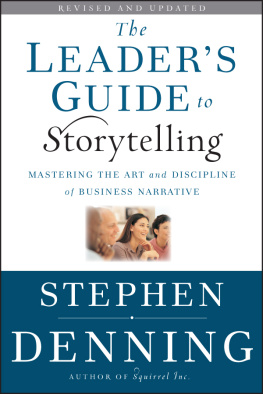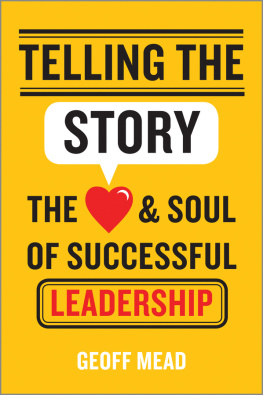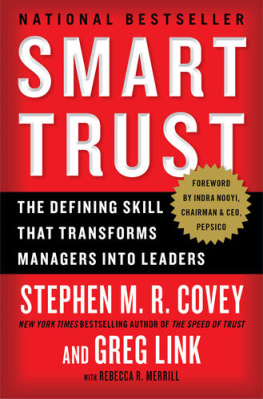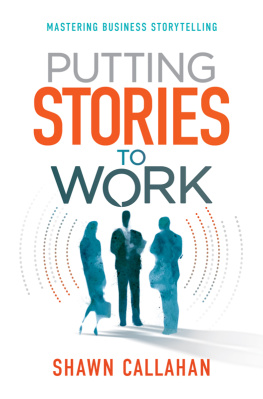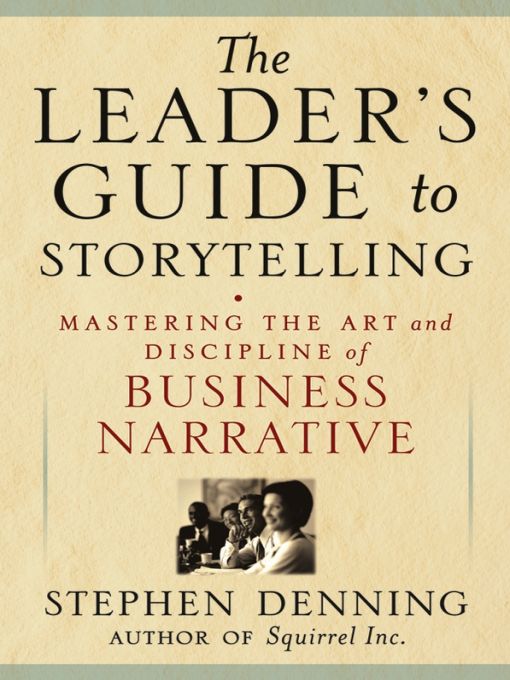Table of Contents
[ INTRODUCTION ]
This book is an account of a simple but powerful idea: the best way to communicate with people you are trying to lead is very often through a story. The impulse here is practical and pedagogical. The book shows how to use storytelling to deal with the most difficult challenges faced by leadership today.
The Different Worlds of Leadership and Storytelling
Storytelling and leadership are both performance arts, and like all performance arts, they involve at least as much doing as thinking. In such matters, performers will always know more than they can tell. I have tried to convey here as much as I can of what worksand what doesntat the intersection of the two different worlds of leadership and storytelling.
For the first several decades of my working life, I remained firmly in the world of leadership and management. Specifically, I was a manager in a large international organization. The organization happened to be the World Bank, but had it been any other large modern organization, the discourse would have been essentially the samerates of return, cost-benefit analyses, risk assessments, performance targets, budgets, work programs, the bottom line, you name it.
The organization happened to be located in the United States of America, but the discourse would not have been much different if it had been situated in any other country. The forces of globalization have rendered the discourse of management and organizations thoroughly international. Its a world almost totally focused on analysis and abstractions. The virtues of sharpness, rigor, clarity, explicitness, and crispness are everywhere celebrated. Its a world that is heavy with practical import: the fate of nations and indeed the economic welfare of the entire human race are said to rest on the effectiveness of the discourse.
It was the force of circumstance, rather than temperament, that led me away from the world of the boardroom, the negotiation table, and the computerized spreadsheet to a radically different worldthe ancient performance art of storytelling. At the time, I was facing a leadership challenge that made the traditional tools of management seem impotent. In trying to communicate a new idea to a skeptical audience, I found that the virtues of sharpness, rigor, and explicitness werent working. Having spent my life believing in the dream of reason, I was startled when I stumbled on the discovery that an appropriately told story had the power to do what rigorous analysis couldntto communicate a strange new idea easily and naturally and quickly get people into enthusiastic action.
Initially, the idea that storytelling might be a powerful tool for management and leadership was so counterintuitive and contrary to my entire education and work-life experience that I had difficulty in believing the evidence of my own eyes. In fact, it took me several years to admit to myself that I was being successful through telling stories.
Soft. Fuzzy. Squishy. Emotional. Fluffy. Anecdotal. Irrational. Fantasy. Fairy stories. Primitive. Childish. These were just some of the terms that the advocates of conventional management hurled at storytelling, which they saw as contaminating the world of pure reason with the poison of emotions and feeling, thereby dragging society back into the Dark Ages. It took a certain amount of intellectual courage to brave this disdain and suggest that the world of rational management might have much to learn from the ancient tradition of narrative.
To build up intellectual stamina to face these challenges, I spent time in the radically different world of storytelling. Not that I was made to feel particularly welcome there. On the contrary, I was initially greeted as an interlopersomeone who risked sullying the noble tales of glorious heroes and beautiful heroines, the figures who made the imagination soar and the heart leap, with the shallow, mean, and dirty world of business, commerce, and making money. To some, I was borrowing the magic language of narrative to accomplish something for which a tersely worded fit-in-or-youre fired memo might be more suitable. The possibility that I might be trying to subvert the fit-in-or-youre-fired approach to solving human problems wasnt always plausible.
What made my reception worse was that I didnt enter the world of storytelling on bended knee in a mood of respectful submission to drink from the ancient fonts of wisdom and accept without question what had been known for millennia about the elements of a well-told story. Instead I arrived with an iconoclastic attitude, suggesting that perhaps it was time to reexamine the eternal verities of storytelling that had been passed on ever since the time of Aristotle. I implied that it might be healthy to throw back the curtains and open the windows and get some fresh air and light on some of these dusty old traditions. To the world of storytelling, this was heresy of the gravest kind. The suggestion that the ancient world of storytelling might actually have something to learn from organizations was as absurd as it was horrifying.
The Intersection of Leadership and Storytelling
The result was that for some years I found myself uneasily inhabiting these two different worldseach profoundly suspicious of the other, each using discourse that supported the validity of its own assumptions and conduct, each seemingly unable or unwilling to grapple with what it might learn from the other. Storytellers could talk to storytellers and managers could talk to managers, but managers and storytellers couldnt make much sense of one another. And what little they did understand of the other sides discourse, they didnt much like. As I gradually learned to converse, more or less successfully, in both worlds, I found myself in the role of go-betweensomeone who reported back from the other world, much as in the thirteenth century Marco Polo reported on his trip to China, telling astonished Venetians that there were strange and wonderful things in that distant world if you took the trouble to go there and check it out. Just as Marco Polo discovered, the very strangeness of my tale rendered my credibility questionable.
Occasionally when I would make a report to managers of what was going on in the world of storytelling, or to storytellers what was happening in the land of management, one of them would say, How interesting! And that is one of the points of this book: to point out matters of profound interest to both the world of storytelling and the world of leadership. So when in this book I take potshots of various kinds at both the world of management and the world of storytelling, please see that they are fragments of a lovers quarrel. If I didnt care deeply about both these worlds, it wouldnt be worth the hassle to undertake the role of dual ambassador.
One of the factors driving me was the awareness that the average manager was not having such extravagant success in meeting leadership challenges that there was no need to learn. Let me cite just a few statistics of the kind that managers love to hang their hats on:
Study after study concludes that only 10 percent of all publicly traded companies have proved themselves able to sustain for more than a few years a growth trajectory that creates above-average shareholder returns.
Repeated studies indicate that somewhat less than 10 percent of major innovations in large corporationsthe ones on which the future is said to dependare successful.


